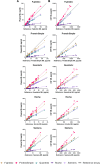This is a preprint.
Measuring neurofilament light in human plasma and cerebrospinal fluid: a comparison of five analytical immunoassays
- PMID: 40654957
- PMCID: PMC12247930
- DOI: 10.1101/2025.05.05.652212
Measuring neurofilament light in human plasma and cerebrospinal fluid: a comparison of five analytical immunoassays
Update in
-
Measuring neurofilament light in human plasma and cerebrospinal fluid: a comparison of five analytical immunoassays.Clin Chem Lab Med. 2025 Sep 8. doi: 10.1515/cclm-2025-0610. Online ahead of print. Clin Chem Lab Med. 2025. PMID: 40958756
Abstract
Objectives: Neurofilament light (NfL) is an established biofluid marker of neuroaxonal injury for neurological diseases. Several high-throughput and sensitive immunoassays have been developed to quantify NfL in blood and cerebrospinal fluid (CSF), facilitating the use of NfL as a biomarker in research and clinical practice. However, because of the lack of rigorous comparisons of assays, it has been difficult to determine whether data are comparable and whether assay performance differs. Here, we compared the performance of five NfL immunoassays.
Methods: To assess the five NfL immunoassays (Fujirebio, ProteinSimple, Quanterix, Roche and Siemens), we used pooled plasma or pooled CSF, as well as unique samples from 20 healthy controls and 20 individuals with El Escorial defined probable or definite amyotrophic lateral sclerosis (ALS), to evaluate precision, parallelism and/or bias. We also examined correlations between plasma and CSF NfL concentrations within and across assays and evaluated their ability to differentiate healthy controls from individuals with ALS.
Results: Four of the five assays demonstrated exemplary performance based on our analyses of precision and parallelism. Across the five assays, NfL concentrations were lower in plasma than in CSF, although they displayed a high degree of correlation. We noted bias across assays; plasma NfL concentrations were lowest for the Roche assay and highest for the ProteinSimple assay. In addition, all assays reliably distinguished healthy controls from individuals with ALS using plasma or CSF NfL.
Conclusions: Four NfL assays demonstrated similar analytic performance. Alongside performance, other factors such as costs, accessibility, useability, footprint, and intended use, should be considered.
Keywords: amyotrophic lateral sclerosis; biomarker; cerebrospinal fluid; immunoassays; neurofilament light chain; plasma.
Figures



References
-
- Khalil M, Teunissen CE, Lehmann S, Otto M, Piehl F, Ziemssen T, et al. Neurofilaments as biomarkers in neurological disorders - towards clinical application. Nat Rev Neurol. 2024;20(5):269–87. - PubMed
Publication types
Grants and funding
LinkOut - more resources
Full Text Sources
Miscellaneous
